If you are reading this while standing over a sticky cast iron pan, don’t fret. We’ve all been there. Even after culinary school, I botched a seasoning.
The good news is that we can fix this mess together. It may take a few steps, but it’s pretty simple. Rest assured you’ve already got the right skills and tools.
In this first part of this article, I’ll give you a handful of reasons why your cast iron may have gotten sticky. That way you can easily avoid similar problems in the future. In the second part, I’ll provide a step-by-step tutorial with pictures on how to fix your sticky cast iron.
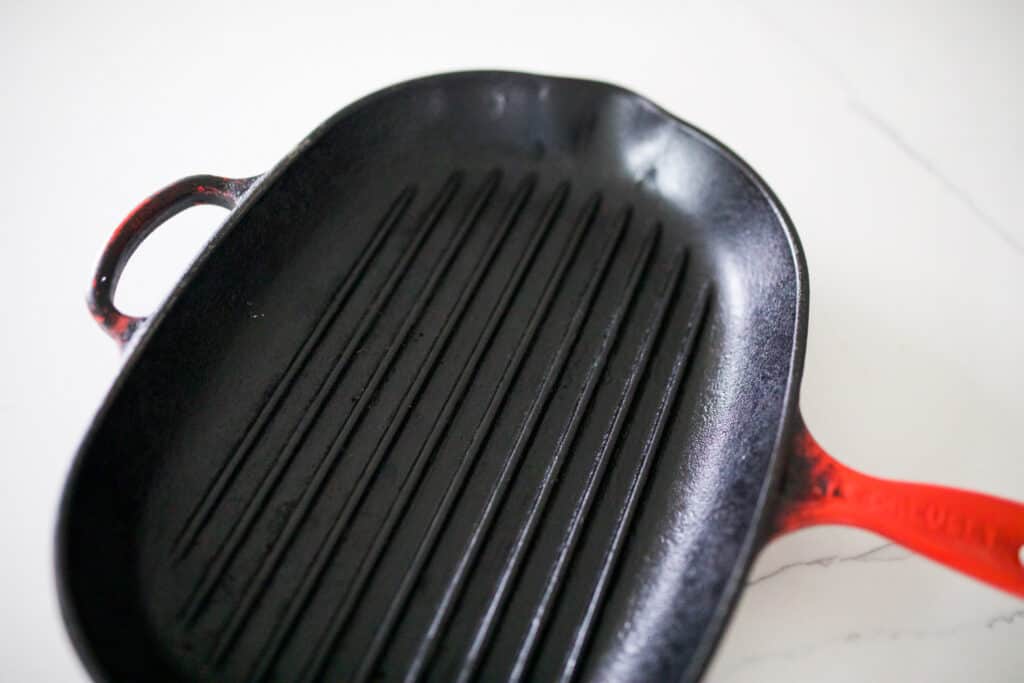
Table of Contents
Reasons Why Your Seasoned Cast Iron Got Sticky
The pan might not have been clean before seasoning.
If there are any leftover traces of food, grease, or cooking oil, it’ll be almost impossible for your seasoning to stick. The goal is to have the seasoning oil bond directly with the iron.
If there’s a layer of gunk in the way, this just won’t happen.
Before seasoning, thoroughly scrub down your cast iron. Use a scouring pad and coarse sea salt, or a scrub brush and dish soap. Either way, make sure that every surface of your cast iron is sparkling clean with no trace of debris.
The pan was cold when you applied the oil.
Metal expands when heated, so you’ll want to apply your seasoning oil to warm cast iron. This expansion will allow the oil to seep into all the pores, divots, and holes. Plus, it’ll form a stronger non-stick bond with the iron during the seasoning process.
Applying oil to a cold pan is like rubbing lotion into a wet leg – it won’t happen. The oil will sit on the surface of the cast iron instead of bonding with it, leading to an uneven, gummy layer.
Try preheating your clean cast iron pan in a 200°F oven for 10 minutes before oiling it. It should be warm to the touch but not too hot to handle.
You may have used too much oil on the cast iron.
Using too much oil is the number one reason why seasoning a cast iron goes wrong.
We’ve just discussed how metal expands when heated, so you can rest assured that even a light pass of oil is seeping into the pan. Less is more, and you can always build up the coating by adding additional, thin layers of seasoning.
Add less oil than you think you’ll need to the pan, and try to make it go as far as possible.
Cover every square inch of the cast iron from the interior and sides to the bottom and handle. Remember the cloth you’re using to spread the oil will absorb some of it and help you spread it further.
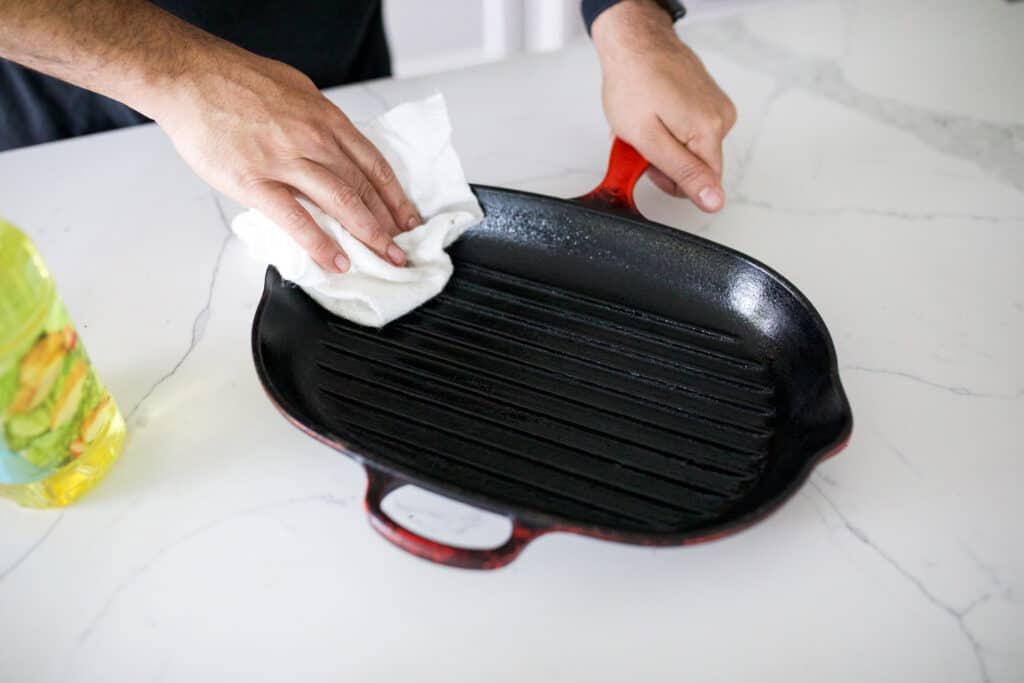
After you’ve coated the pan with oil, buff it away with a separate clean cloth. Put some elbow grease into it, like you’re trying to remove as much oil as possible.
Repeat this buffing step before baking the pan upside down in the oven. Inverting the pan will prevent excess oil from dripping down the sides and pooling in the bottom of the pan. Place a baking sheet on the bottom rack of the oven to catch any excess.
Maybe you used the wrong type of oil or fat.
Although you can use virtually any fat to season cast iron, some are better suited for the job than others.
Fats that are solid at room temperature, like lard, bacon grease, or butter, are more challenging to season cast iron with. This is because their saturated fat molecules don’t readily bond with other molecules, like the cast iron itself. As a result, it’s easy for the seasoning process to go sideways with this fat, often leading to an uneven, patchy, and, yes, sticky surface.
You’re better off using oils that are liquid at room temperature since the unsaturated fats will readily bond with the cast iron.
Take your pick of high-smoke point cooking oils. If you’re using EVOO, you are using the wrong oil. With unsaturated fat, you’ll notice a smooth, even, uniform seasoning layer that’s easy to add additional layers on top of.
You can find our list of best oils to season cast iron here.
The oven wasn’t hot enough to polymerize the oil.
The non-stick coating created during the seasoning process is all thanks to a chemical reaction called polymerization. This happens when oil is heated past its smoke point. It transforms from a wet, liquid consistency to a slick, hard surface that’s molecularly bonded to the iron.
To ensure that this reaction occurs and avoid the dreaded sticky seasoning, look up the smoke point of your oil. Then set your oven above that temperature.
I usually set my oven to “cleaning” and allow the cast iron to bake at upwards of 500°F for about an hour.
How To Fix Sticky Buildup in Cast Iron
Step 1: Bake It Longer
If your skillet clearly could use a cleaning, jump to step 2.
Otherwise, crank up the heat to 500°F on your oven and put the cast iron in to bake for an hour or so. The oven must go beyond the smoke point of the oil used to season it, or it won’t polymerize.
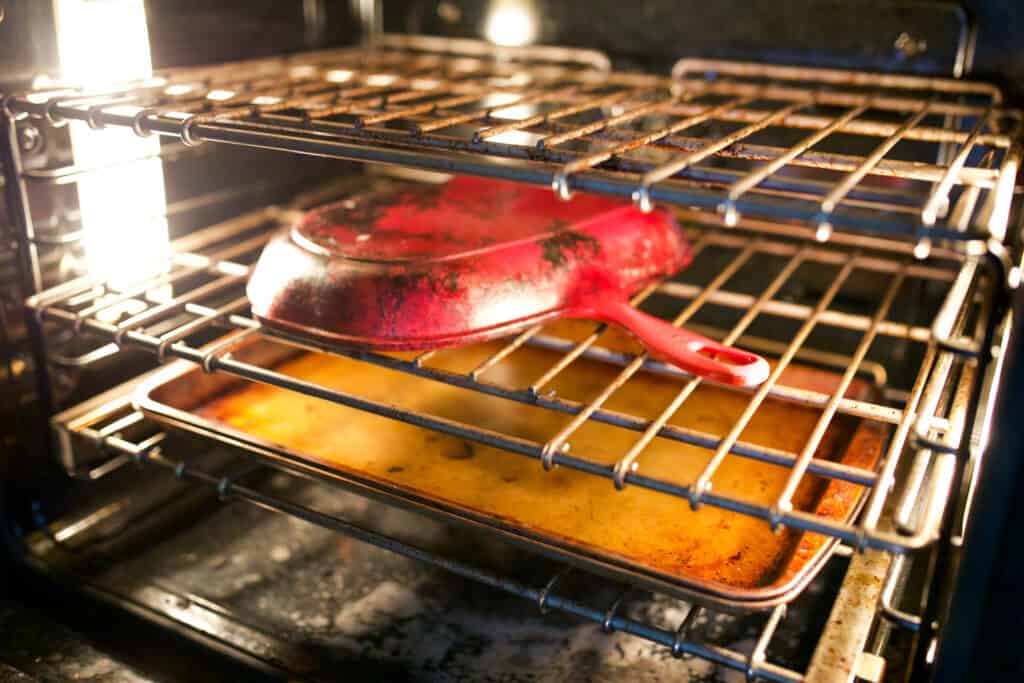
If your pan is still sticky, scour the pan to remove the gummy coating and start seasoning again from scratch. Maybe there’s too much oil residue building up over time.
Step 2a: Scour the Pan
Use a scouring pad and coarse sea salt, if you have it handy, to scrub down all sides of the pan to remove the tacky oil coating. Next, give the pan a rinse and dry it thoroughly.
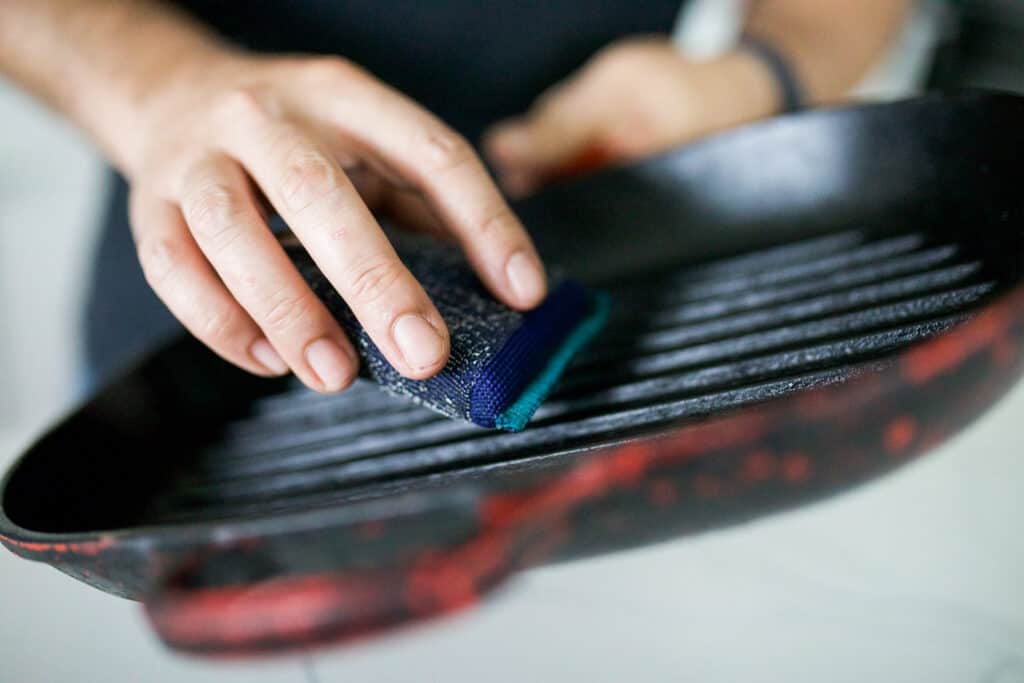
It’s important to scrub away every trace of gunk in this step so that you can start from a blank slate to re-season the pan. If a scouring pad with salt doesn’t work, try soap next.
Step 2b: Use Soap if Needed to Rid Sticking
Conventional wisdom says not to use soap on a cast iron pan, but the truth is that this “rule of thumb” comes from a bygone era.
Not so long ago, soaps were heavily lye-based. That meant that regular dish soap was abrasive enough to remove a polymerized seasoning. That’s not the case anymore.
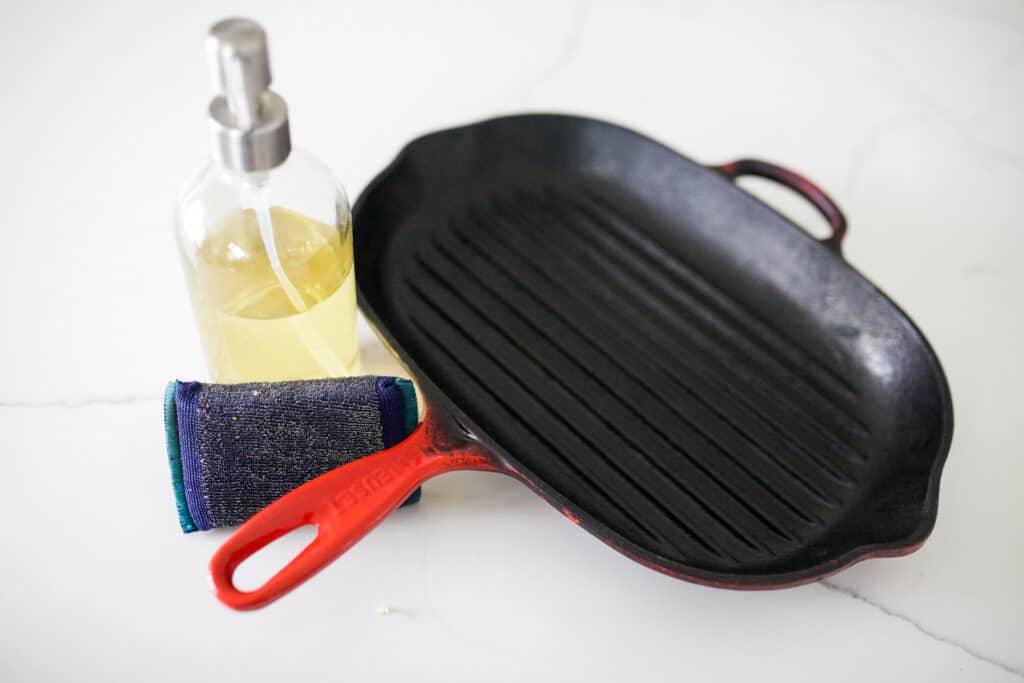
If your pan is especially “gunky,” then try washing it away with dish soap and your steel wool scouring pad. Give it a good scrubbing. Our goal is to create a blank canvas for a quality new seasoning, so if we lose a little of the old in the process, that’s just the cost of doing business.
Step 3: Seasoning It Again
This time make sure that you’re starting with a clean and dry cast iron piece. No rust, crumbs, or caked-on brown bits are allowed.
Use a cotton or microfiber cloth to apply a very light coating of oil to the entirety of the pan—top, bottom, and handle.
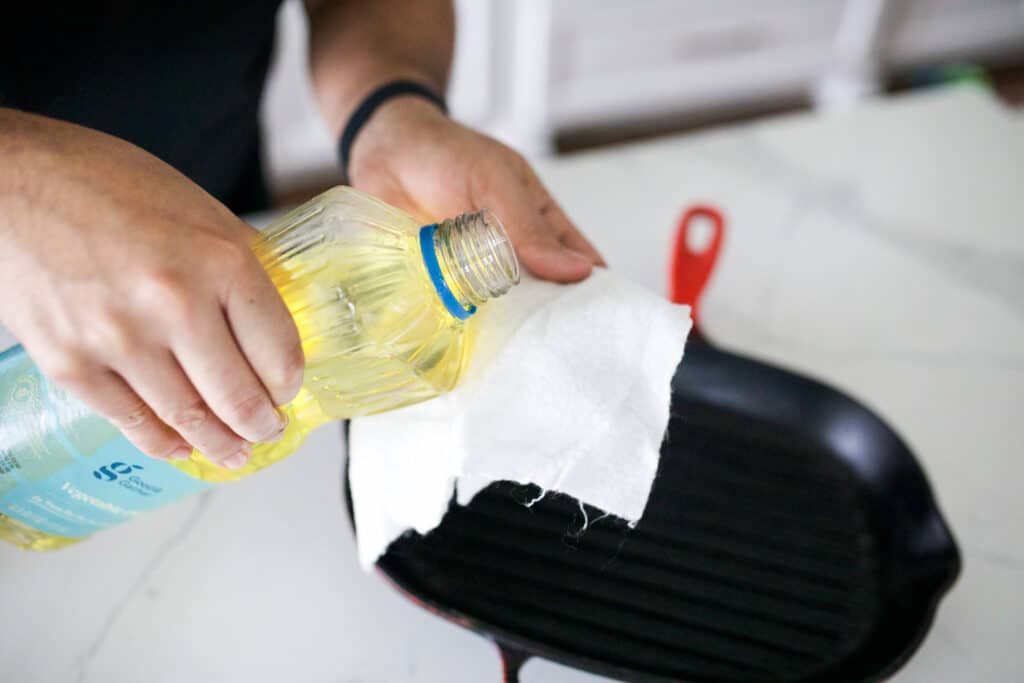
Take a separate clean cloth and buff the entire pan again and remove excess oil. Remember, cast iron is porous, so it’s already soaked up the oil it needs from the first pass, so you can really give a good wipe-down in this step.
Place the pan upside down into a pre-heated, high-temperature oven for about an hour. Place a baking sheet on the bottom rack of the oven to catch any excess. The temperature is dependent on the type of oil you use. For the chemical reaction that creates a non-stick coating to occur, you need the pan to be heated passed the oil’s smoke point.
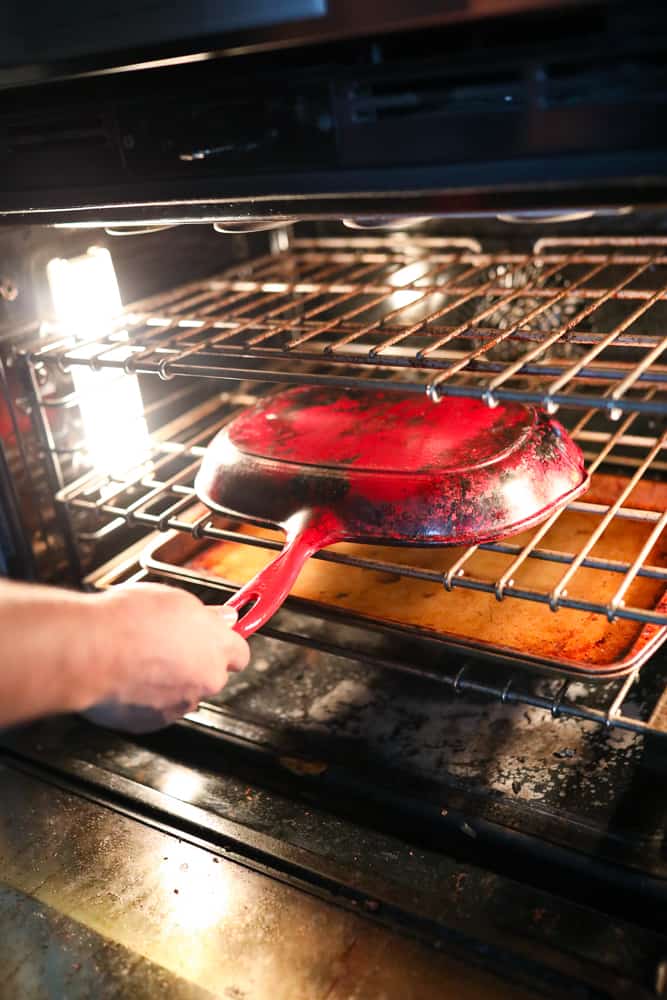
Then, remove it from the oven, admire your job well done, and get cooking on your seasoned cast iron!
And if you’re wondering can you use cast iron on a glass top stove, we have you covered.
FAQs: Cast Iron Sticky After Seasoning
You’ll know that your cast iron is well-seasoned when you pull it from the oven, and it’s a dark, shiny black. The surface won’t feel sticky after seasoning and will be smooth, not rough.
You shouldn’t cook with a sticky cast-iron pan because the food will stick. This will not only ruin the meal you’re trying to prepare, but it’ll also make correctly seasoning the pan more laborious.
If you can avoid using soap to wash your cast iron, that’s best. Try just giving the pan a thorough wipe down and rinse, which is the best-case scenario. Otherwise, you can use a small amount of mild soap to clean the pan of debris sticking. However, an excess of harsh soap can strip away the seasoning. So, if you plan to clean with soap often, you’ll just have to re-season the pan accordingly.
Using too much oil will leave an oil slick in the pan that will ultimately lead to a sticky build-up in your cast iron cookware. Using too much oil is the number one mistake made when seasoning cast iron.
Yes, you can cook immediately after seasoning your cast iron. Polymerization has occurred with heat and doesn’t need to cool to complete. Your pan has been seasoned.
You want to use a high smoke point oil, so do not use extra virgin olive oil (EVOO) when seasoning cast iron.

